| |
"I don't go anymore. I don't see why humanity likes that which stresses stupidity and lowliness. Sex, obscenity, violence, ugliness, decadence and degeneration don't interest me. Excesses disgust me. What I like is effort, the will to go beyond oneself. For me, life is to be oneself in the face of friends who you punch in the nose, and then you drink and sing together. It is the attraction to real women, and not the Miss Bovarys. It's the fresh air, the great outdoors, the great hopes." |
| |
Director John Ford answering the question in
1965 "What do you think of cinema today?" |
You get a clear idea that Ford wouldn't think too much of today's digitally drenched mainstream cinema of spectacle either. Ford died in 1973, just a few short years before Jaws revolutionised Hollywood. Many of his silent films are forever lost but his surviving body of work is a significant and (given its historical context) a magnificent testament to a long vanished cinematic era of men being men, women being women and I'm not sure it had a lot to say about small, furry creatures from Alpha Centauri. John Ford projected a hard, crusty shell around himself forever antagonistic with the world in general and Hollywood executives in particular. It was well known that this shell was necessary only because his sleeve-located heart could break so easily. If there's one film in his extraordinary back catalogue that thrusts that vulnerable heart into the audience's lap, it's The Quiet Man.
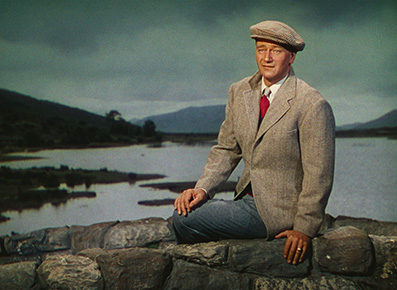
In 1952, John Wayne was still enjoying a long running popularity unrivalled by any movie star at that time. He plays Sean Thornton, an ex-prizefighter with a tragic past. He's returning from America to the place of his birth and childhood, Innisfree, a highly fictionalized and fantasy version of the real town of Inishmore, an island off the west coast of Southern Ireland. The movie was partly shot in County Mayo and County Galway just a stone's throw north. Before arriving at the cottage of his birth, he sees and is captivated by a red-headed beauty, Mary Kate Danaher, played by Maureen O'Hara. Attempting to buy the cottage, he meets Mary Kate's burly brother Red played by the impressively sized Victor McClaglen, almost as tall as Wayne but much rounder. The men clash from the off but Sean needs Red's respect and permission to woo the sister. Believing there is some advantage in having his sister move out of the family home, Red relents grudgingly. The chaste wooing is overseen by Michaeleen (Barry Fitzgerald), a character who seems to embody almost every Irish cliché Ford could summon up in his fantasy Emerald Isle. Forever on the prowl for an alcohol hit, Michaeleen does, however, get the best sight gag, a very risqué one for 1952.
Schemes are schemed and obstacles are thrown in the way of true love and Sean is often thwarted but the love-struck couple eventually marries. There's a small problem. Mary Kate does not yet have her material possessions and fortune still held by her obstinate brother. Sean is afraid of what he might do to Red if he lost his temper so keeps his fists to himself. But this is a John Ford picture and the fight between Sean and Red has been so obviously telegraphed from the very start of the film that we cannot wait for its eruption and it's a corker even if we do have to accept that we are in hyper-violent, super-punchy, no-real-injury fantasyland incarnate. This isn't the place to criticise The Quiet Man for its violence but I will mention that it was the one film of my childhood that convinced me that punches ended after a long swing and did little more than make the recipient shake their head before replying with one of their own. It was also the birth in my imagination of that specific Hollywood fantasy sound effect that a fist makes on a chin, a sort of ‘chirthsk' noise (my God, someone find an onomatopoeic spelling for me. You know the sound…) It makes a mockery of the reality of a late night drunken brawl – one punch ending in a broken knuckle, a broken chin and a lengthy wait in A & E.
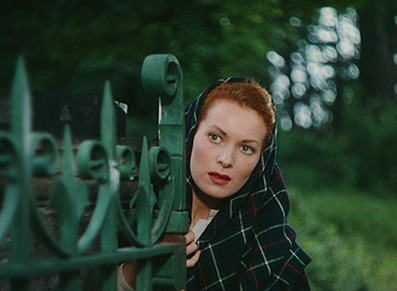
After a short search, I was surprised to find that this is the first John Ford movie we've reviewed on Outsider. Of course Ford's been name checked throughout the site but I find it a little startling that it's taken this long to line up a Ford movie for retrospective appreciation. Mea Culpa. Ford was at the very top of a selective list of genuine cinematic artists rustled up my friend, director Richard Franklin. I had to admit to him many times over that Ford's worldview and mine were not sympathetic to each other and many of Ford's admittedly classic pictures are those I mustered little enthusiasm for despite universal acclaim. I saw this slight discord as a generational characteristic and I still hold to that. Ford made the bulk of his movies before I was alive so his world and mine scarcely collided but that doesn't mean respect for his abilities cannot be granted. After all, Ford still holds the record for ‘Best Director' Oscars (four). But where ‘Jack' really outdid himself, more than satisfying my own criteria for great cinema, was with two films that shine out of his canon like nova light. Aside from the magnificent The Searchers, The Quiet Man is his most accessible to me personally even though I recognise it's his least ‘real' picture and definitely a fantasy of outrageous but heartfelt sentiment and riotously over the top machismo. But it's clear from the quote above that Ford was a man's man who cultivated the now decidedly sexist demarcation of men and women's roles in society. He liked his women strong but he also kept them in the kitchen. To be fair, there wasn't a great deal a filmmaker who was born in the nineteenth century could do with the pre-assigned roles human beings happily and unhappily slotted themselves into in that period of our history. Ironically, he found his cinematic muse and avatar in a man called Marion, a huge hunk of a chap with an all too distinctive walk and acting style, one called ‘reacting'. John Wayne was everything a man aspired to be in John Ford's eyes. If there is significance in a name (and if I was a man with the name of Marion, I'd change it too), it's no surprise that Ford too went by another moniker celebrating his Irish roots despite him being born in the state of Maine, USA.
The Hollywood filmmaker John Ford, also known as Sean Aloysius O'Feeny, was destined to make The Quiet Man. The idea had been around for almost twenty years until Ford garnered enough commercial clout to realise a personal dream. Typecast as strongly as any actor, Ford rarely strayed from the western or war genre. With this out and out romance trying hard to keep its fisticuffs in check, Ford made his ultimate Irish fantasy. The picture is so intoxicating, it's hard to break it out of its green bubble and realise that the ‘Oirish' are not all loveable alcoholics given to breaking into song at the drop of a hat. Ford managed the same feat in his portrayal of the Welsh in How Green Was My Valley. I'm Welsh (not that this means anything) but it was hard not see his ode to miners as anything but a well-meaning Hollywood fantasy. In fact, there is a plethora of modern arguments that could easily ridicule The Quiet Man's politics, its sexual politics, its overstated and obstinate use of stock clichés and its unwavering belief that to be a man you have to be able to take several hundred punches and then get overwhelmingly pissed together with your opponent.
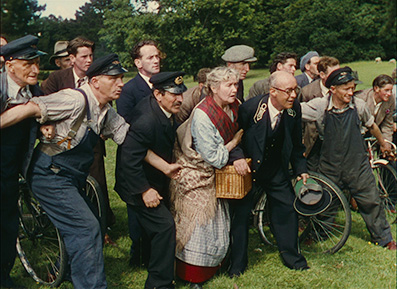
If ever Hollywood lied about violence, here is that lie underlined with blarney and softened with the unshakeable belief of its director and leading man. The basic notes of ‘The Rakes of Mallow' are well known. Dun dun, dun dun, dun dun, duddle du da dun dun, dun dun, dun dun… repeat - Google it. Chances are you'll recognise the tune. This melody has come to typify a non-existent if unrealistically pugilistic Ireland. Steven Spielberg uses the very hummable melody as the prelude to another giant fight in his one out and out misfire, 1941 (which is where I first heard it believing it to be a John Williams original, slap my wrist). Spielberg also quotes Ford's The Quiet Man visuals and his composer Victor Young's work in, of all movies, E.T. You remember the school frog liberation scene and the mental link that E.T. and Eliot share? It's The Quiet Man's extraordinary first kiss scene that Eliot re-enacts tipsy as E.T. watches the movie on TV, drunk on beer. By the way, in researching this, I re-watched E.T.'s twentieth anniversary version and was horrified to see a computer generated E.T. God, it almost completely ruins the movie. Avoid it and stick with the animatronic no matter how restricted the puppet's mouth movement is. Even the regretful Spielberg has the same recommendation. I guess that this is what happens having the influence of George "Let's go back and fix it!" Lucas at your side. I've rechristened the 2002 makeover… C.G. The Extra Nonsensical.
As usual, Ford uses his stock company, all of whom acquit themselves with a light touch and in some cases the outright buffoonery that the script requires. Telling the story in voiceover is Father Peter Lonergan, played by Ford regular Ward Bond. Bond and Wayne were close friends and often baited each other in inane but entertaining bets. I hope this is true (it was a story Richard told me) but Bond once bet Wayne that they could stand on the same sheet of newspaper and Wayne could not move his friend off it. Bond then slid the page under a door and invited Wayne to stand on the other side of it. After a second or two Wayne punched through the door and sent Bond sprawling. The other notable Ford player in the film is his own brother, Francis Ford, who plays Dan Tobin, a bearded old timer on his death bed, revived by the promise of witnessing Red and Sean's fisticuffs. The young fresh-faced Jack MacGowran (a genuine Irishman amongst a bevy of Americans) plays Red's whipping boy, Ignatius. If you can add about twenty years to that face, you'll recognise the first human victim of Regan MacNeil from The Exorcist, the film director whose head is found twisted around one hundred and eighty degrees.
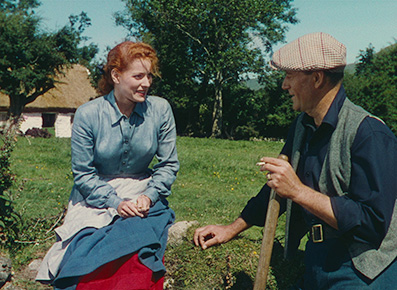
Technically, The Quiet Man has a few very obvious process shots, the actors ensconced in Los Angeles studios while Irish scenery is played behind them. And there is not a production designer, set builder or director on planet Earth that can make a studio into a convincing beach. Hell, there are even echoes from the commentators' megaphones. Echoes? On a beach? There are a few inexplicably speeded up shots that make some of the violence seem a little cartoony. But the location Technicolor photography of Winton C. Hoch is never less than edible. He and Jack Cardiff must have studied from the same giant art gallery. In fact, in the famous first kiss scene I was almost persuaded that someone had re-coloured Mary Kate's skirt, apron and blouse (respectively red, white and blue) in light of the recent horrific events in Paris, so vibrant were they. The editing by Jack Murray is solid but there is an extraordinary jump cut in a flashback that I am at a loss to understand. It seems there's a shot missing. But aside from this hic-cough, the editing compliments Ford's style which is, in essence, wide shots, long shots and mid shots presented simply, unadorned with any camera movement that might call attention to itself.
In this simplicity Ford achieves little pleasures that other directors may miss. About nine and a half minutes in, when Wayne claps eyes on O'Hara as the latter is herding sheep, there's a delicious mid shot from a low angle showing Mary Kate sharing what the Italians call ‘the thunderbolt' with Sean as he stares at her in an ordinary mid shot. As we cut back to Mary Kate, she's still looking at him and eventually she turns away (there's a flicker of a look into camera that is furtive but if you're looking for it, it's right there) but she cannot resist another look back at this handsome stranger. A great percentage of directors would tilt the camera down to follow her movement. A great percentage of editors would cut out before the character became too small in frame. Ford and Murray let it play on a static shot and her final look back is shown with O'Hara as a tiny figure crossing the centre of the lower frame line. It looks ordinary. Trust me, it is anything but. But the most famous story of The Quiet Man must be at the expense of the studio executives who were worried that a film over two hours long (the movie's running time is nine minutes over two hours) would not be able to play as often per day as desired in cinemas. After a screening, the executives asked John Ford to cut the film down to two hours. He dutifully did so and invited the executives to another screening. Mere minutes into the long awaited and hugely anticipated fight, a card came up on screen saying ‘The End'. Ford had made his point and retained his original cut.
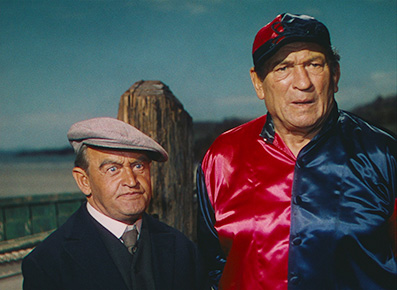
Among the higher echelons of film cognoscenti, Ford is known as a poet of cinema. If this is true, then The Quiet Man is his simple limerick: Satisfying, humourous and, in almost every sense, whimsical as anyone ever may have imagined Ireland to be. As good old-fashioned entertainment, The Quiet Man is, like its leading man Sean Thornton, hard to beat.
One of the things we always tend to remember about The Quiet Man is its vivid, almost fantasy world colour, but much of this is down to the over-saturation you'll find on some earlier video transfers, something vividly illustrated by the garish clips included in the documentary extra The Making of The Quiet Man detailed below. One of the key things the restoration on this Masters of Cinema release puts right is to more accurately grade Winton C. Hoch's Technicolor photography, which reigns in the saturation and, at least when it comes to the daylight exteriors, delivers a somewhat more naturalistic palette, albeit with the sort of warm bias common in Technicolor films of the period. Make no mistake, though, when brighter colours appear, they still beam. The contrast is also at its most pleasing here, nailing solid black levels without harming the shadow detail, though this does soften a little on lamp-lit interiors. The colour also has a more visible golden hue here. The sharpness and picture detail are excellent, particularly on the daytime exteriors, the best of which look absolutely glorious. There's hardly a dust spot to be seen and not the slightest movement of the image within the 1.37:1 frame. On the whole a terrific job, and certainly the best I've ever seen the film looking.
The Linear PCM mono 2.0 soundtrack is also in good shape. The range restrictions are inevitable for a film of this vintage, but the dialogue is always clear with no distortion, the music cleanly reproduced and there's little trace of background hiss and no pops, crackle or other sundry damage to content with.
Optional English SDH subtitles are also available.
Tag Gallagher (17:20)
John Ford and The Adventures of Roberto Rossellini author Tag Gallagher delivers a video essay on The Quiet Man comprised largely of extracts from the film and underscored by his own observations on its themes and motifs. Plays a little like a highbrow poetry reading at times, and his claim that if you watch a shot of John Wayne kissing Maureen O'Hara kissing in slow motion "you can watch her go through a hundred emotions" is just a weeny exaggeration, but a number of interesting points are still made.
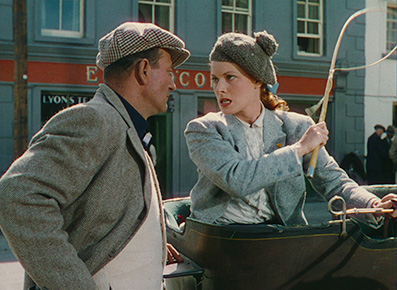
The Making of The Quiet Man (27:54)
A 1992 documentary on the making on the film, hosted and narrated by a typically upbeat and ever-smiling Leonard Maltin, who talks directly to camera from an armchair by the fire. He outlines how a film that no studio wanted to make finally went into production and provides info on the crew's arrival in Ireland, as well as taking a look at some of the scripted sequences that didn't make it into the film. There are useful contributions from John Wayne's son Michael and daughter Toni, as well as John Ford regular Victor McLaglen's son Andrew V. McLaglen, who worked as an uncredited assistant on the film and later made a career as a director himself. A little cheesy in places – "It's a film that people love," Maltin tells us with a salesman smile, "which is only fitting as so much love went into it" – but there's still a good deal to enjoy here, including an archive TV interview with Wayne and Ford from 1959. Booklet
The booklets that accompany Masters of Cinema releases are always a treat, but this is one of their best for some time and covers almost all the bases that any fan of the film would hope for. It kicks off with a solid appreciation of John Wayne's performance titled Being On Screen: John Wayne in The Quiet Man by Sheila O'Malley, which is followed by an intriguing profile of the actor from an August 1953 edition of Look magazine. There are more archive goodies in the reproduction of a profile of John Ford by Laddie Marshack from a 1955 edition of The Catholic Digest, and a welcome article on cinematographer Winton C. Hoch entitled Master of Technicolor by John Gallagher, which was first published in American Classic Screen in 1982. Best of all is the inclusion of original story by Maurice Walsh on which the film is based, which has been reproduced here in its original short story form (it was later revised and expanded on by the author) as it appeared in the Saturday Evening Post in 1933. Credits for the film, stills and notes on viewing have also been included. Excellent.
A John Ford favourite has been given a lovely makeover for this Masters of Cinema Blu-ray release. The on-disc extras are good, but it's the booklet that really shines here, an excellent companion to the film whose content has been impeccably selected. Warmly recommended.
|